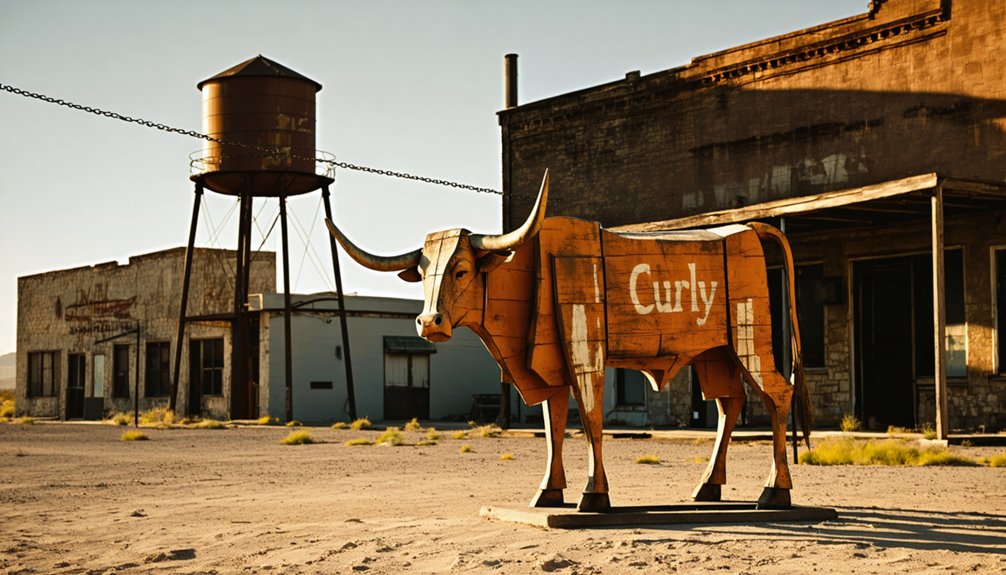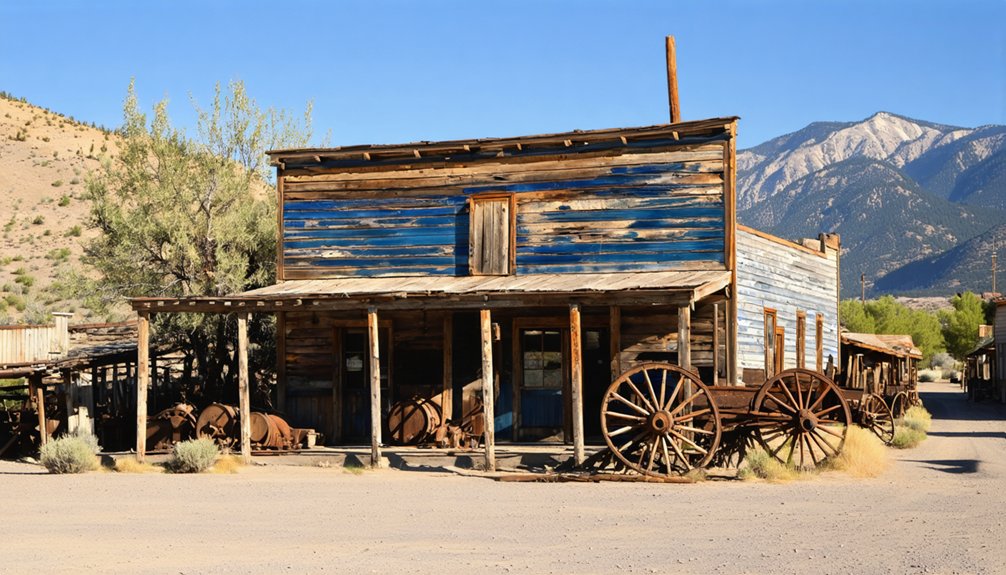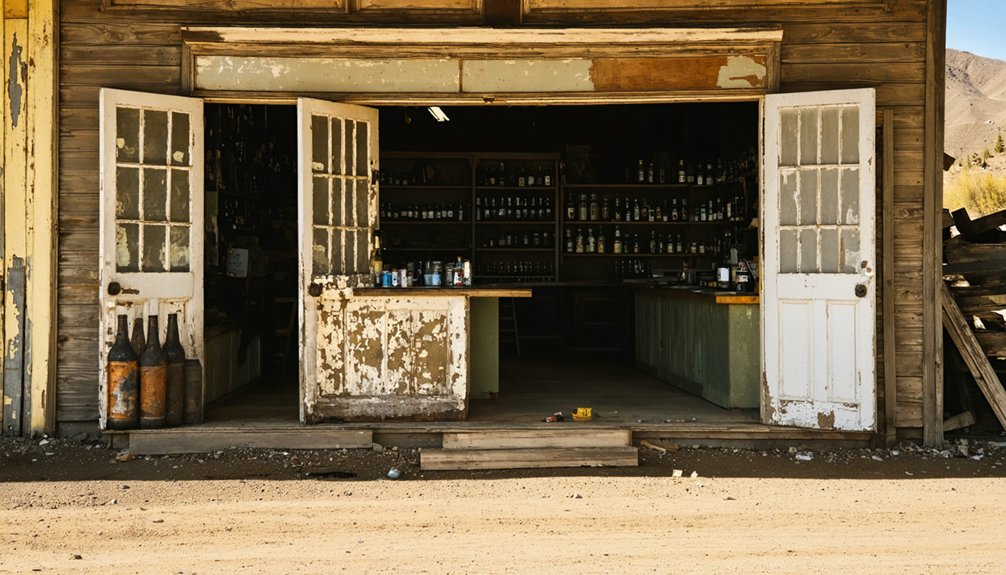Borel was a once-thriving Gold Rush camp in Kern County, California that peaked in the mid-1800s when over 300,000 prospectors flooded the region. By the early 1900s, as gold reserves dwindled, it evolved into a ghost town with just 150 residents. In July 2024, a devastating wildfire destroyed most of its historic structures, including the replica courthouse museum, though the old schoolhouse survived. Curly the Bull’s remarkable survival story has become a symbol of the community’s resilience amid loss.
Key Takeaways
- Borel was established during California’s Gold Rush in Kern County as a bustling mining camp that later declined as gold reserves diminished.
- By the early 1900s, Borel had transitioned into a ghost town with a population of only 150 people.
- In July 2024, the Borel Fire destroyed over 200 structures including historical buildings, but remarkably spared the old schoolhouse.
- The town once featured saloons, boarding houses, and general stores during its peak Gold Rush prosperity.
- Preservation efforts for Borel and similar ghost towns face challenges from climate change and increasing wildfire threats.
The Rise and Fall of a Gold Rush Era Town
While countless fortune seekers flooded into California during the Gold Rush, the establishment of Borel in Kern County marked yet another chapter in the state’s fevered pursuit of mineral wealth.
You’d have found a raw, bustling camp where prospectors built makeshift shelters and dove into placer mining operations with dreams of striking it rich.
Gold mining brought swift economic fluctuations to Borel, as thousands of miners poured in, creating a temporary boom.
The influx of gold-seeking migrants transformed Borel into an overnight boomtown, though prosperity proved as fleeting as the precious metal itself.
Much like the Julian Banner mining district’s Stonewall Mine, Borel experienced significant production during its peak years.
You’d have seen saloons, boarding houses, and general stores spring up to serve the diverse crowd of fortune hunters.
The small settlement grew rapidly as over 300,000 gold-seekers migrated to California between 1848 and 1855.
But like many Mother Lode settlements, Borel’s fortunes wouldn’t last.
As gold reserves dwindled, miners moved on, businesses shuttered, and buildings crumbled.
A Town’s Legacy Erased: The Borel Fire’s Devastation
In July 2024, you’d have witnessed California’s historic town of Havilah vanish as the Borel Fire tore through nearly 60,000 acres of Kern County, destroying over 200 structures including the replica courthouse museum and its irreplaceable Gold Rush artifacts.
Historical society president Roy Fluhart tragically lost the town’s archives when flames engulfed the buildings.
The fire’s devastating path, sparked by a single-vehicle accident on Highway 178, consumed both original and reconstructed buildings from the 1920s while creating 100-foot fire tornadoes that transformed the pine-oak forests into ashen landscapes. While most of the town was destroyed, the old schoolhouse managed to survive the devastating blaze.
Yet you’ll find the community’s spirit remains unbroken, as evidenced by their united efforts to help displaced families and the symbolic survival of Curly, a two-ton bull who became the mascot of their resilience.
Historic Heritage Lost Forever
Through a devastating wildfire, Borel lost its cherished historical legacy when flames consumed the town’s replica courthouse museum and its irreplaceable collection of Gold Rush-era artifacts.
You’ll never see the carefully curated archives, antique mining tools, and historic photographs that once told the cultural legacy of this Sierra Nevada settlement.
The blaze destroyed not just public exhibits but also the personal heritage items of long-standing local families, erasing generations of historical narrative preserved in homes and workshops.
Like the historic Bad Man from Bodie, the town’s infamous reputation for lawlessness and violence would be lost to time as the fire ravaged through its historical records.
The records’ destruction impacted the ability to access valuable information through internal links that once connected visitors to detailed historical accounts.
Local historical societies had spent years safeguarding these treasures, only to watch their preservation efforts vanish in the inferno.
The fire’s destruction has left an unfillable void in the region’s ability to share its mining heritage with future generations.
Fire’s Path of Destruction
A tragic pickup truck crash on Highway 178 near Kern River Canyon sparked the devastating Borel Fire on July 24, 2024, setting in motion one of the region’s most destructive wildfires.
You’d hardly recognize the historic mining town of Havilah (Borel) today – the fire’s impact obliterated over 230 homes and businesses, leaving only the old schoolhouse and a few scattered structures standing.
Triple-digit temperatures and fierce winds pushed flames through sun-baked slopes and steep terrain, devouring nearly 60,000 acres of unburned vegetation.
The community response rallied around “Curly the Bull,” a surviving mascot, as residents faced the total loss of their town’s physical heritage.
Over 1,200 firefighters worked tirelessly to battle the blaze in hazardous conditions.
What remained was a stark indication of nature’s raw power: a solitary museum plaque amid the rubble, marking where a vibrant mining community once stood.
Local resident Mark Carruthers watched helplessly as the inferno consumed his century-old home and workshop.
Community Spirit Endures Strong
While devastating flames consumed their physical town, Havilah’s residents demonstrated remarkable resilience through their unified response to the Borel Fire disaster. Their community bonding crystallized around Curly the Bull, a two-ton survivor who became their symbol of perseverance.
You’ll find their resilience strategies evident in how neighbors rallied to care for the injured bull and support displaced families.
Despite losing century-old homes and precious heirlooms, residents haven’t surrendered their emotional connection to Havilah. They’re gathering regularly to share resources, process trauma, and preserve their town’s legacy through storytelling.
Even without water and electricity in many areas, you’ll witness determined community members working to restore infrastructure and plan rebuilding efforts. Local organizations and volunteer groups continue providing logistical and emotional support as recovery progresses.
Tales From the Wild West: Historic Main Street
During the height of California’s Gold Rush in the 1860s, Havilah’s Main Street pulsed with the raw energy of the Wild West, where gunfights erupted at high noon and gold dust changed hands freely in crowded saloons.
As Kern County’s first seat of government, this bustling thoroughfare hosted everything from stagecoach robberies to high-stakes horse races. Like in Bodie, most shootouts ended with only one bullet hitting the intended target. You’d have found dance halls, gambling houses, and inns lining the street, drawing fortune-seekers from across the frontier.
But like many wild west towns, Havilah’s glory faded as gold deposits ran dry. By the early 1900s, it had transformed into a ghost town, its population dwindling to just 150 souls.
Today, after the devastating 2024 Borel Fire, only the old schoolhouse stands as a reminder of Main Street’s vibrant past.
Curly the Bull: A Symbol of Resilience

You’ll find no better symbol of Borel’s endurance than Curly the Bull, who survived the devastating 2024 Borel Fire that destroyed over 200 structures across 60,000 acres.
Despite severe burns to his legs and undersides, Curly’s fight for survival sparked a community-wide support movement, with locals selling t-shirts and organizing fundraisers for his veterinary care and to help his owners, the Carruthers family, rebuild their century-old home.
Through social media updates and local coverage, Curly’s recovery has become intertwined with the region’s healing process, serving as a powerful reminder of the resilience that defines this fire-affected California community. Multiple caregivers work in shifts around the clock to ensure the injured bull receives proper care and attention.
Fire Survival Story
In the face of a devastating wildfire that ravaged Borel, California, a lone bull named Curly emerged as an unforgettable symbol of survival and resilience.
As a 100-foot-tall fire tornado ripped through the region, destroying over 200 structures, Curly somehow found shelter that protected his lungs from deadly smoke and heat.
You’ll notice his remarkable animal resilience in how he repeatedly rose when appearing near death, standing defiantly despite severe burns on his legs and underside.
His wildfire recovery has become the community’s rallying point.
Standing along the only road into Havilah, Curly greets returning residents as “the last man standing.”
The bull’s perseverance inspired locals to create “not today” t-shirts, funding both his medical care and rebuilding efforts in a town otherwise reduced to ashes.
Community Support Movement
Curly’s remarkable survival sparked a widespread movement of community support that transformed a local tragedy into a story of collective action and hope.
You’ll find Havilah’s resilience embodied in their grassroots fundraising efforts, with “not today” t-shirts featuring Curly the Bull raising funds for veterinary care while creating a tangible symbol of shared resilience.
The community rallied around this bovine survivor in three distinct ways:
- Establishing rotating care networks among neighbors, first responders, and ranchers
- Mobilizing social media to coordinate resources and spread Curly’s story beyond regional boundaries
- Adopting Curly’s image as an emblem of local identity and defiance
When you visit today, you’ll notice how this bull’s presence along the main road continues to unite residents in ongoing recovery efforts, maintaining community spirit despite devastating losses.
Local Recovery Icon
Standing defiantly amid the charred landscape where Borel’s historic structures once stood, Curly the Bull has transformed from livestock to living legend following the catastrophic 60,000-acre fire that devastated Havilah.
Despite severe burns rendering him immobile, Curly repeatedly stands up—embodying the “Not today” spirit that resonates with displaced residents facing their own rebuilding challenges.
Mark Carruthers and his veterinarian wife lead Curly’s Care efforts, applying topical treatments while the community rallies around their iconic survivor.
You’ll find Curly’s image on fundraising T-shirts throughout the region, with proceeds supporting his medical expenses.
For a community without water and electricity months after the disaster, this bull represents Community Resilience at its most visceral—the last man standing when everything else fell.
His daily presence reminds locals that standing back up is always possible.
Preserving California’s Ghost Town Heritage

Preserving California’s ghost town heritage has become a sophisticated endeavor encompassing legal frameworks, community involvement, and specialized conservation techniques.
At sites like Bodie State Historic Park, you’ll find the “state of arrested decay” policy prioritizing authenticity over reconstruction, maintaining buildings’ historical integrity while preventing complete deterioration.
California’s approach to ghost town preservation balances three essential elements:
California’s ghost town preservation masterfully intertwines legal protections, community engagement, and educational storytelling to safeguard authentic historical narratives.
- Legal protection through historic designation that prevents commercial development
- Community volunteer programs that engage in structural maintenance and historical interpretation
- Educational initiatives that tell complete stories beyond romanticized narratives
You can witness this cultural heritage conservation firsthand through museums, guided tours, and educational programming.
These preservation efforts guarantee that California’s mining history remains accessible while respecting the authenticity that makes these abandoned places so compelling.
Climate Change and Historic Preservation Challenges
As preservation efforts fortify California’s ghost towns against conventional threats, an unprecedented challenge now looms over these fragile historic sites.
You’ll find these historical treasures increasingly vulnerable to climate-driven wildfires, like the devastating 2024 Borel Fire that obliterated Havilah’s replica courthouse and irreplaceable artifacts.
Rising temperatures accelerate wooden structure deterioration while changing precipitation patterns trigger erosion and flooding, destabilizing historic foundations.
Climate adaptation strategies now require sophisticated monitoring systems and reinforced preservation methods, stretching already limited resources.
Preservation funding challenges remain significant, with federal and state grants rarely meeting the mounting costs of climate resilience.
Small historic sites particularly struggle as maintenance expenses soar.
The collaboration between preservationists and climate scientists offers hope, but securing long-term funding for these vulnerable pieces of California’s heritage remains critical.
Frequently Asked Questions
Are Any Descendants of Original Havilah Settlers Still in the Area?
Just as gold vanished from those hills, direct descendant connections to original Havilah settlers have mostly disappeared from the immediate area. You’ll find settler legacy preserved mainly through historical societies rather than resident bloodlines.
What Happened to the Gold Mines After Havilah Was Abandoned?
After abandonment, you’d find Havilah’s gold mines either collapsed or flooded. Some reopened briefly when improved mining equipment made extraction viable, but most became historical relics of California’s gold mine history.
How Accessible Is Havilah for Tourists After the Fire?
Where once gold seekers risked all, you’ll now find charred history. Havilah’s accessibility is extremely limited after the 2024 fire destroyed most structures. Visit at your own risk—tourist safety isn’t guaranteed in this devastated landscape.
Were Any Historical Artifacts Recovered From the Destroyed Museum?
Almost no artifact recovery occurred after the museum’s destruction. Only one item was retrieved by Governor Newsom from the wreckage. You’ll find nothing else survived the devastating Borel Fire.
How Does Havilah Compare to Other Fire-Destroyed Ghost Towns?
Unlike other ghost towns that faded gradually, Havilah’s destruction was sudden and total, with irreplaceable historical archives lost in the 2024 Borel Fire—more catastrophic than typical ghost town deterioration.
References
- https://www.latimes.com/environment/story/2024-08-04/california-history-reduced-to-ash-borel-fire-destroys-havilah
- https://www.parks.ca.gov/?page_id=26330
- https://en.wikipedia.org/wiki/Bodie
- https://www.desertsun.com/story/news/nation/california/2024/07/29/historic-kern-county-mining-town-wiped-out-as-fires-ravage-california/74587938007/
- https://www.kvpr.org/environment/2024-10-02/earthquakes-fires-flooding-in-kern-county-the-borel-fire-was-a-reminder-of-climates-wrath
- https://www.sfgate.com/california-wildfires/article/california-gold-town-wiped-out-borel-fire-19602490.php
- https://www.visitmammoth.com/blogs/history-and-geology-bodie-ghost-town/
- https://www.youtube.com/watch?v=DQZ8Zz_VMD8
- https://en.wikipedia.org/wiki/California_gold_rush
- https://capitolmuseum.ca.gov/state-symbols/gold-rush-ghost-town-bodie/



